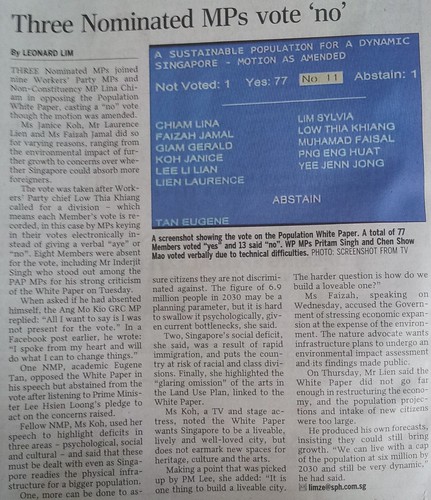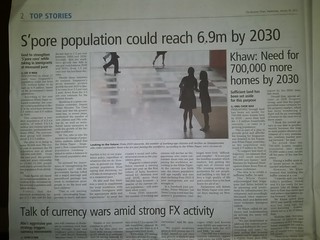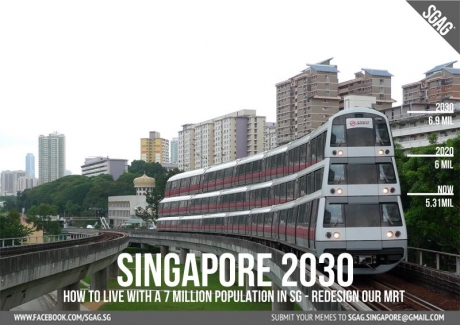read also Singapore population can’t keep rising (Part 1)
“Today, there are large numbers of high-end immigrants entering the country, many from China and India…..they are better educated, more hard-working and driven, and better able to compete against professional Singaporeans in many areas of work. And they compete not just for jobs but also for scarce resources such as private property and certificates of entitlement to buy cars. High-end immigration is infinitely more threatening to the local population than low-end labour, and explains a great deal of the angst and anxiety felt by Singaporeans, including those in the professional class.”– Han Fook Kwang
“When we have 6.9 million people we will have even less space for making mistakes. I would urge the government to think three times before we move.” – Opposition MP Chen Show Mao
“Beyond a tipping point, a country populated by immigrants loses its feeling if home. Singapore is arguably reaching that point.” – Chua Mui Hong in “In search of a new narrative”
“In the past, Singaporeans would have probably just complained in coffee shops before going about their everyday business, but not anymore. For many, the White Paper was the last straw. A protest organized at Hong Lim Park – the only space in the country where citizens are allowed to protest without a permit – drew a crowd of over 3,000 people, all of whom were fed up with the government’s policy and lack of serious engagement.” – Kirsten Han
“One is witnessing an anger startling not in its intensity, but by the way it cuts across all demographics of society…. the anger is widespread, even amongst some staunch PAP grassroots leaders.” – Calvin Cheng
“when a Government has not been able to adequately handle a population increase from 3 million to 5 million, what faith do the people have that it can do so from 5 to 6.9?” – Calvin Cheng
“Singapore is a nation of immigrants, as we know from history. But we are no longer the sleepy fishing village of the early 19th century. The Government cannot justify exploding the population with foreigners on the basis that this was done in the early dawn of our nation’s history. We are a modern city with vastly different needs and social circumstances.”– Ng E Jay
 The population white paper is one of the most controversial planning document which flops badly and receives little buy-in in the short history of Singapore. How unpopular is the document:
The population white paper is one of the most controversial planning document which flops badly and receives little buy-in in the short history of Singapore. How unpopular is the document:
 When the White Paper on Population was released, reactions came fast and furious. It even trigger one of the largest legal protest in modern Singapore at Hong Lim Park with more than 3000-500 attendees despite little publicity.
When the White Paper on Population was released, reactions came fast and furious. It even trigger one of the largest legal protest in modern Singapore at Hong Lim Park with more than 3000-500 attendees despite little publicity.- For the first time, they got the highest reject votes in the parliament: 10 from opposition parties which is expected, but all the 3 non-partisan Nominated MPs voted against except one who abstained his vote (NMP Eugene opposed the white paper in his speech but abstained form the vote). PAP Mr. Inderjit Singh who stood out for his strong criticism on the white paper absent himself from the voting. It may be his conscientiousness at play but it is likely to cost his MP seat in the next election. Such fine good man who stood by his principal since Tan Soo Khoon!!!
 The Government wants GDP growth but this is not what the people one, want proof? See this voting result from a local TV. How overwhelming is the result? If put to a national referendum, you can be sure that the white paper will be voted down.
The Government wants GDP growth but this is not what the people one, want proof? See this voting result from a local TV. How overwhelming is the result? If put to a national referendum, you can be sure that the white paper will be voted down.
- It has further divided the country as the “US (the locals) vs THEM (Foreigners, New Citizens, PRs)” debate reach the highest level since independence. For the first time in our short history that anti-Foreigner (including new citizens) sentiment is so obvious among the locals.
- When the headlines across all major newspapers are screaming “6.9m people by 2030”, midway through the debate this has become “6.9 million population figure in 2030 is not a target and the Government is not deciding now on any specific population size for beyond 2020“. If it is just planning parameters, we are sure to hit and surpass it based on past records, who are the PM kidding?
 Singapore is becoming more polarised and politicised than ever on immigration and integration; those who voice strong opposition to foreigner-friendly policies find themselves risking being called xenophobic even if they are not (xenophobic = an intense dislike or fear of people from other countries). Singapore has been accepting immigrants since independence from Malaysia, Indonesia, Hong Kong and Taiwan without causing much discomfort to the local population as the immigrants have come in smaller numbers and are similar to Singaporeans in terms of culture, language and beliefs and have few problems assimilating into Singapore society. No longer the case in the last few years when droves of China and Indian immigrants are let in sincd LHL took over.
Singapore is becoming more polarised and politicised than ever on immigration and integration; those who voice strong opposition to foreigner-friendly policies find themselves risking being called xenophobic even if they are not (xenophobic = an intense dislike or fear of people from other countries). Singapore has been accepting immigrants since independence from Malaysia, Indonesia, Hong Kong and Taiwan without causing much discomfort to the local population as the immigrants have come in smaller numbers and are similar to Singaporeans in terms of culture, language and beliefs and have few problems assimilating into Singapore society. No longer the case in the last few years when droves of China and Indian immigrants are let in sincd LHL took over.
Why the white paper is a disastrous PR exercise and no buy-in from Singaporeans:
- people want the Governement to solve the current problem first before we talked about the vision in 2030;
- the emphasis should be on getting local Singaporeans (the retirees, the housewives, handicapped, the illiterates etc) and the non-Singaporean dependents (who are already living here) to re-enter the workforce – and not bringing in more foreign labour;
- the ageing population should not be considered dependents or hindrances to a dynamic Singapore, but rather a rich source of untapped manpower resource, many of whom still have much to offer our country;
- allowing more foreigners into Singapore = economic growth and enhanced quality of life is a “false dilemma”;
- No mention of the ultimate population that this island can take;
- Diluting of the Singaporean “core” with less than 55% of Singaporeans by 2030. And this “core” is also highly questionable as many are imported “New Citizens” who share little common background, culture and aspiration of this country;
- Worry of sardin-packed city with even fewer green spaces;
- More infrastructure constructions ahead;
- The income gap will get even bigger;
- No address of the social issues in the white paper
For the policy makers who like technicalities but still not convinced that they have got it all wrong, hopefully the following extract will make them worry and reverse the flawed population policy: In his famous 1960s “mouse universe” experiment, behavioural scientist John B. Calhoun’s showed how an ever-increasing number of mice living in a safe but finite living space resulted in a gradual breakdown in normal behaviour. Over a two-year timeframe when the original mice were allowed to breed freely before resulting in overcrowding, the following changes were seen in the mice’s behaviour: expulsion of young before weaning was complete, wounding of young, inability of dominant males to maintain the defence of their territory and females and increased aggressive behaviour of females. After day 600, the social breakdown continued and the population declined toward extinction. During this time, females stopped reproducing. Their male counterparts withdrew completely and stopped engaging in courtship or fighting. They ate, drank, slept, and groomed themselves – alone. The process was eventually termed “behavioural sink”, and the conclusions drawn from this experiment were that, to quote Wikipedia, “when all available space is taken and all social roles filled, competition and stress experienced by individuals will result in a complete breakdown in complex social behaviours, ultimately resulting in the demise of the population”. Worryingly, the experiment also showed that the change in behaviour became permanent even after the mice population was reduced to a comfortable number. In short, there is no turning back. Related articles:


Recent Comments